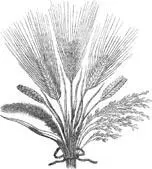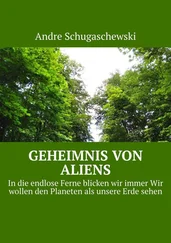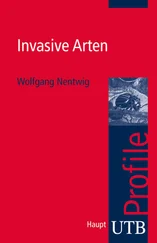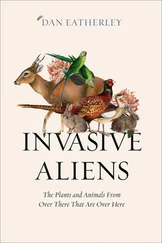Ecologists also fear that invasive organisms could alter ecosystems in far more profound ways. These could include anything from changing water quality or soil nutrient levels to disrupting food webs, reducing pollination rates and generally messing about with the ‘balance of nature’. Examples at random from around the world include the Mediterranean tamarisk tree, blamed for drying up marshes and salinising the soil in California, or zebra mussels altering nitrogen and phosphorus levels in freshwater habitats. One school of thought suggests that since ecosystems are dynamic and ever-changing, perhaps we shouldn’t be too bothered. Such an attitude is simplistic and defeatist. Much of what humans – the most ‘invasive’ species of all – have done, from cutting down rainforests to spilling oil into the sea, from landfilling toxic waste to pumping out carbon dioxide, has upset ecosystems, and we need to understand and combat those negative effects however subtle. Right now – not for want of research – our understanding of how ecosystems function, how different organisms interact, and what makes these complex systems more resilient, or less, remains limited, with plenty of knowledge gaps left to fill. We are instinctively concerned each time a species is lost from a natural system through our actions (or negligence); we should also perhaps feel a similar disquiet whenever we cause a new one to be added.
If the invaders left people alone and restricted their impacts to the degrading of natural ecosystems, that would be bad enough – not least as we ultimately depend upon these systems for our survival and wellbeing. But some non-natives harm us directly. Notwithstanding the odd pinch on the privates from a crayfish, the obvious threat is their role as agents of disease. The most notorious example in history is offered by the Black Death, inflicted by a strain of bacteria originating in Asia which, from the fourteenth century onwards, has killed tens of millions across Europe, the Middle East and North Africa. While nothing on that scale has recently been visited upon us here in Britain, new parasites and pathogens are on the radar, many transmitted by mosquitoes and other biting insects. At the moment, it’s a bit chilly for these to get a foothold here, but with climate change all bets are off.
Judging by the growing scientific literature devoted to the economic impacts of biological invaders, these species hurt our pockets too. Much of the cost arises from direct impacts such as insect pests reducing yields from agriculture and forestry, fish stocks wiped out by disease or the erosion caused when signal crayfish or Chinese mitten crabs tunnel into river banks. To the ledger we must add the eye-watering sums spent on preventing, monitoring and eradicating invasives. In excess of £5 million is spent every year in Britain removing Japanese knotweed alone. Various indirect impacts, trickier to calculate but just as real, and many times greater than the direct costs, can also be attributed to invasives. This is a complex area, but it boils down to the loss of valuable ecosystem services like nutrient cycling, pollination or flood prevention.
Overall costs incurred by invasive non-native organisms are estimated to amount to 5 per cent of the global economy. Across Europe, invasives inflict some £9-billion worth of damage every year. In the UK alone, the figure has been put at about £1.7 billion annually. Although these are ballpark estimates, resting on plenty of assumptions and subject to much debate, governments the world over are taking notice as never before. Invasive species are fast becoming public enemy number one. In 2016, the European Union banned 37 of the most problematic plants and animals from being kept or traded without a permit. These include signal crayfish, raccoons and American skunk cabbage. On this side of the Channel, the Great Britain Non-Native Species Secretariat was set up a decade ago and tasked with detecting and containing invaders, as well as helping to predict and prevent future incursions. Tackling troublesome non-natives is complex: the measures taken can be extraordinary and sometimes cause more problems than they solve, even hurting the very ecosystems they’re intended to protect.
An emerging school of thought is suggesting that the threat of invasive species has been exaggerated, that we should stop worrying about non-natives and even welcome them for the benefits they can bring. At the other extreme, a growing band of conservationists is going beyond simple calls for the eradication of non-natives to campaign for the deliberate reintroduction of a menagerie of native British plants and animals which have become extinct at the hands of humans. To its critics, the ‘re-wilding’ movement is pure eco-nostalgia.
For me though, most fascinating of all is that non-native organisms, invasive or otherwise, from rabbits to rhododendrons, mink to muntjac, hold up a mirror to our own species. Yes, the pace of invasion is higher than ever before but problematic non-natives aren’t a modern phenomenon: they’ve been with us from the outset, as unavoidable a corollary of the human way of life as cleared forests and piles of garbage. From the earliest settlement of our islands and first experiments with farming, through the Roman and medieval times, and the age of exploration by Europeans, to the current period of globalised free-for-all, the story of invasive species is the story of our own past, present and future.
2 Contents Cover Title Page Copyright Dedication Epigraph Prologue 1 Ecological Explosions 2 First Invaders 3 Romans and Normans 4 New Worlds, New Invaders 5 The Empire Strikes Back 6 The Plant Hunters 7 Unwanted Hitch-Hikers 8 Fur Farm 9 Freshwater Invaders 10 Underneath the Waves 11 Fighting Fire with Fire 12 The Future Further Reading Index of Species General Index Acknowledgements About the Book About the Author About the Publisher
First Invaders Contents Cover Title Page Copyright Dedication Epigraph Prologue 1 Ecological Explosions 2 First Invaders 3 Romans and Normans 4 New Worlds, New Invaders 5 The Empire Strikes Back 6 The Plant Hunters 7 Unwanted Hitch-Hikers 8 Fur Farm 9 Freshwater Invaders 10 Underneath the Waves 11 Fighting Fire with Fire 12 The Future Further Reading Index of Species General Index Acknowledgements About the Book About the Author About the Publisher

‘But while men slept, his enemy came and sowed tares among the wheat, and went his way. But when the blade was sprung up, and brought forth fruit, then appeared the tares also.’
King James Bible, Matthew 13:25–26
For a million years a windswept peninsula in a corner of northwest Europe had seen various species of humans coming and going. The arrivals and departures were synchronised to the advance and retreat of continental glaciers, a dance choreographed by climatic change. They barely registered. A cluster of footprints here, a tidy pile of knapped flints there. Overwintering in caves, the people would emerge to gather shellfish from grass-fringed estuaries, pad through woodland in search of berries and nuts or pick at the carcasses left by lions and giant hyenas. The more ambitious, coveting the freshest meat, bone and fur, would rally family and friends in adrenaline-fuelled pursuits of deer, horse or mammoth.
Make no mistake, even the earliest people were unusual. Britain had never welcomed visitors quite like them, and over the aeons these experiments in humanity forged in the evolutionary crucible of an African valley generated ever more sophisticated results: the grunts of the most obtuse of cavemen took on deeper meanings; people fashioned better weapons and perfected their hunting techniques; they got the hang of butchery and learned to tame fire. Humans would turn their new-found skills on each other from time to time. Yet, for a great sweep of history, these pioneers – Homo antecessor , Homo heidelbergensis and maybe others – were but minor players on a stage dominated by rhinoceros and sabre-toothed cat, bison and bear. A low profile was often the best strategy given the monsters with which the land was shared. People were no more masters of their destiny than were grains of pollen in the air. And, every time the cold rushed back in and the fragrance of the dwindling forest was lost once more to the bitterness of endless tundra, so would humans again retire to more hospitable refuges in southern and southeastern Europe, abandoning the briefly colonised outpost to musk ox, wolverine and ice.
Читать дальше












